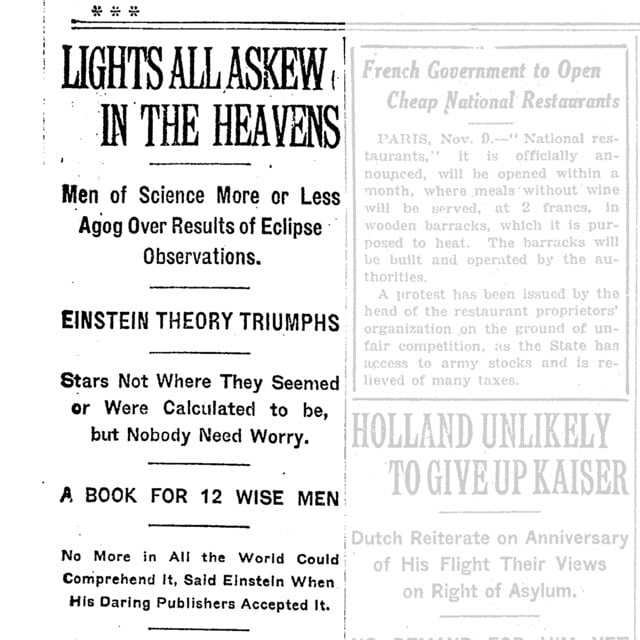Earlier this year, the LIGO experiment detected evidence of gravitational waves. Now the evidence shows that those waves may have echoes, which would contradict one of the tentpoles of modern physics, the general theory of relativity.
It was hailed as an elegant confirmation of Einstein’s general theory of relativity — but ironically the discovery of gravitational waves earlier this year could herald the first evidence that the theory breaks down at the edge of black holes. Physicists have analysed the publicly released data from the Laser Interferometer Gravitational-Wave Observatory (LIGO), and claim to have found “echoes” of the waves that seem to contradict general relativity’s predictions.
The echoes could yet disappear with more data. If they persist, the finding would be extraordinary. Physicists have predicted that Einstein’s hugely successful theory could break down in extreme scenarios, such as at the centre of black holes. The echoes would indicate the even more dramatic possibility that relativity fails at the black hole’s edge, far from its core.
If the echoes go away, then general relativity will have withstood a test of its power — previously, it wasn’t clear that physicists would be able to test their non-standard predictions.

After a potential detection of gravitational waves back in 2014 turned out to be galactic dust, scientists working on the LIGO experiment have announced they have finally detected evidence of gravitational waves. Nicola Twilley has the scoop for the New Yorker on how scientists detected the waves.
A hundred years ago, Albert Einstein, one of the more advanced members of the species, predicted the waves’ existence, inspiring decades of speculation and fruitless searching. Twenty-two years ago, construction began on an enormous detector, the Laser Interferometer Gravitational-Wave Observatory (LIGO). Then, on September 14, 2015, at just before eleven in the morning, Central European Time, the waves reached Earth. Marco Drago, a thirty-two-year-old Italian postdoctoral student and a member of the LIGO Scientific Collaboration, was the first person to notice them. He was sitting in front of his computer at the Albert Einstein Institute, in Hannover, Germany, viewing the LIGO data remotely. The waves appeared on his screen as a compressed squiggle, but the most exquisite ears in the universe, attuned to vibrations of less than a trillionth of an inch, would have heard what astronomers call a chirp — a faint whooping from low to high. This morning, in a press conference in Washington, D.C., the LIGO team announced that the signal constitutes the first direct observation of gravitational waves.
The NY Times headline above is from when the concept of gravitational lensing suggested by Einstein’s theory of relatively was confirmed in 1919. I thought it was appropriate in this case. Wish they still ran headlines like that.
Update: The LIGO team has detected gravitational waves a second time.
Today, the LIGO team announced its second detection of gravitational waves-the flexing of space and time caused by the black hole collision. The waves first hit the observatory in Livingston, Louisiana, and then 1.1 milliseconds later passed through the one in Hanford, Washington.
By now, those waves are 2.8 trillion or so miles away, momentarily reshaping every bit of space they pass through.
A man outfitted his family minivan with high-precision cesium clocks to demonstrate to his kids that they gained 22 nanoseconds of vacation time on their mountain camping trip than they would have at a lower altitude.
A moving mass has been shown to generate a gravitomagnetic field (just like a moving electrical charge creates a magnetic field) and “the measured field is a surprising one hundred million trillion times larger than Einstein’s General Relativity predicts”. (via rw)
A relativistic examination of gravity in the galaxy may indicate that the invention of dark matter may not be necessary to solve the not-enough-matter problem. “The motions of stars in galaxies is realized in general relativity’s equations without the need to invoke massive halos of exotic ‘dark matter’ that nobody can explain by current physics.”
Update: mjt has doubts about the paper referenced here and notes that there’s other evidence for dark matter that is not questioned by the above study.
Brian Greene on Einstein’s most famous equation, E =mc^2. When he finally gets around to it in the middle of the article, Greene’s got a pretty good layman’s explanation of what the formula actually means.
PBS has put up a companion web site to the Nova program on Einstein airing in October. Features include audio clips of several physicists describing e=mc^2 to non-physicists.






Stay Connected